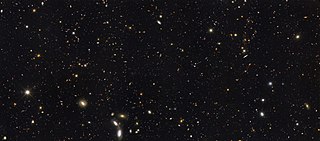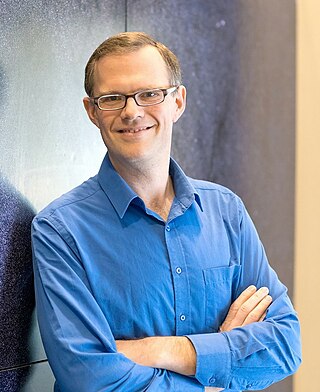
The following is a timeline of galaxies, clusters of galaxies, and large-scale structure of the universe.

A galaxy cluster, or a cluster of galaxies, is a structure that consists of anywhere from hundreds to thousands of galaxies that are bound together by gravity, with typical masses ranging from 1014 to 1015 solar masses. They are the second-largest known gravitationally bound structures in the universe after some superclusters (of which only one, the Shapley Supercluster, is known to be bound). They were believed to be the largest known structures in the universe until the 1980s, when superclusters were discovered. One of the key features of clusters is the intracluster medium (ICM). The ICM consists of heated gas between the galaxies and has a peak temperature between 2–15 keV that is dependent on the total mass of the cluster. Galaxy clusters should not be confused with galactic clusters (also known as open clusters), which are star clusters within galaxies, or with globular clusters, which typically orbit galaxies. Small aggregates of galaxies are referred to as galaxy groups rather than clusters of galaxies. The galaxy groups and clusters can themselves cluster together to form superclusters.

The Hubble Deep Field (HDF) is an image of a small region in the constellation Ursa Major, constructed from a series of observations by the Hubble Space Telescope. It covers an area about 2.6 arcminutes on a side, about one 24-millionth of the whole sky, which is equivalent in angular size to a tennis ball at a distance of 100 metres. The image was assembled from 342 separate exposures taken with the Space Telescope's Wide Field and Planetary Camera 2 over ten consecutive days between December 18 and 28, 1995.

A barred spiral galaxy is a spiral galaxy with a central bar-shaped structure composed of stars. Bars are found in about two thirds of all spiral galaxies in the local universe, and generally affect both the motions of stars and interstellar gas within spiral galaxies and can affect spiral arms as well. The Milky Way Galaxy, where the Solar System is located, is classified as a barred spiral galaxy.

An astronomical survey is a general map or image of a region of the sky that lacks a specific observational target. Alternatively, an astronomical survey may comprise a set of images, spectra, or other observations of objects that share a common type or feature. Surveys are often restricted to one band of the electromagnetic spectrum due to instrumental limitations, although multiwavelength surveys can be made by using multiple detectors, each sensitive to a different bandwidth.

The Extended Groth Strip is an image of a small region between the constellations of Ursa Major and Boötes, based on the results of a series of observations by the Hubble Space Telescope. It covers an area 70 arcminutes across and 10 arcminutes wide, which correlates to a patch of sky roughly the width of a finger stretched at arm's length. The image was assembled from over 500 separate exposures taken with the Space Telescope's Advanced Camera for Surveys at 63 different pointings, spread out over the course of one year from June 2004 to March 2005. The complete image at the highest resolution in JPEG format is nearly 250 megabytes.

The Cosmic Evolution Survey (COSMOS) is a Hubble Space Telescope (HST) Treasury Project to survey a two square degree equatorial field with the Advanced Camera for Surveys (ACS). The largest survey ever undertaken by HST, the project incorporates commitments from observatories around the world, such as the Very Large Array radio observatory, the European Space Agency's XMM-Newton satellite, and Japan's eight meter Subaru telescope. At the moment, more than 150 astronomers around the world actively contribute to the project.

Galaxy Zoo is a crowdsourced astronomy project which invites people to assist in the morphological classification of large numbers of galaxies. It is an example of citizen science as it enlists the help of members of the public to help in scientific research.

The Great Observatories Origins Deep Survey, or GOODS, is an astronomical survey combining deep observations from three of NASA's Great Observatories: the Hubble Space Telescope, the Spitzer Space Telescope, and the Chandra X-ray Observatory, along with data from other space-based telescopes, such as XMM Newton, and some of the world's most powerful ground-based telescopes.

Christopher J. Conselice is an astrophysicist who is Professor of Extragalactic Astronomy at the University of Manchester.

In astronomy, a Hubble bubble would be "a departure of the local value of the Hubble constant from its globally averaged value," or, more technically, "a local monopole in the peculiar velocity field, perhaps caused by a local void in the mass density."

Duília de Mello is a Brazilian astronomer. She is currently full professor in physics at the Catholic University of America and collaborates with NASA Goddard Space Flight Center.

The Cosmic Assembly Near-infrared Deep Extragalactic Legacy Survey (CANDELS) is the largest project in the history of the Hubble Space Telescope, with 902 assigned orbits of observing time. It was carried out between 2010 and 2013 with two cameras on board Hubble – WFC3 and ACS – and aims to explore galactic evolution in the early Universe, and the very first seeds of cosmic structure at less than one billion years after the Big Bang.

GN-z11 is a high-redshift galaxy found in the constellation Ursa Major. It is among the farthest known galaxies from Earth ever discovered. The 2015 discovery was published in a 2016 paper headed by Pascal Oesch and Gabriel Brammer. Up until the discovery of JADES-GS-z13-0 in 2022 by the James Webb Space Telescope, GN-z11 was the oldest and most distant known galaxy yet identified in the observable universe, having a spectroscopic redshift of z = 10.957, which corresponds to a proper distance of approximately 32 billion light-years. Data published in 2024 established that the galaxy contains the most distant, and therefore earliest, black hole known in the universe, estimated at around 1.6 million solar masses.
Sangeeta Malhotra is an astrophysicist who studies galaxies, their contents, and their effects on the universe around them. The objects she studies range from our own Milky Way galaxy to some of the earliest and most distant known galaxies in the epoch of cosmic dawn.

Peter Lawrence Capak is currently the Architect of Perception Systems at the Oculus division of Facebook. His current focus is developing machine perception technologies, sensors, displays, and compute architectures for the next generation of augmented (AR), mixed (MR) and virtual reality (VR) systems. His research has focused on using physical modeling and advanced statistical methods including artificial intelligence and machine learning to extract information from very large multi-wavelength (hyper-spectral) data sets. He has primarily used this to study structure formation in the universe, cosmology, and the nature of dark matter and dark energy.

SMACS J0723.3–7327, commonly referred to as SMACS 0723, is a galaxy cluster about 4 billion light years from Earth, within the southern constellation of Volans. It is a patch of sky visible from the Southern Hemisphere on Earth and often observed by the Hubble Space Telescope and other telescopes in search of the deep past. It was the target of the first full-color image to be unveiled by the James Webb Space Telescope (JWST), imaged using NIRCam, with spectra included, showing objects lensed by the cluster with redshifts implying they are 13.1 billion years old. The cluster has been previously observed by the Hubble Space Telescope (HST) as part of the Southern MAssive Cluster Survey (SMACS), as well as Planck and Chandra.
Caitlin M Casey is an observational astronomer and associate professor at the University of Texas at Austin. She is known for her work in extragalactic astrophysics; she works on the formation and evolution of massive galaxies in the early Universe.
Jeyhan Sevim Kartaltepe is an American astronomer, Associate Professor and Director of the Rochester Institute of Technology Laboratory for Multiwavelength Astrophysics. Her research considers observational astronomy and galaxy evolution. She is a lead investigator on the Cosmic Evolution Early Release Science Survey and the COSMOS-Webb Survey conducted on the James Webb Space Telescope.



















